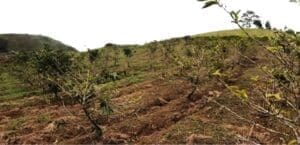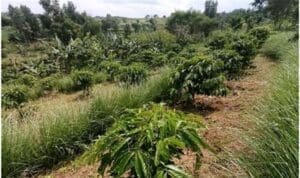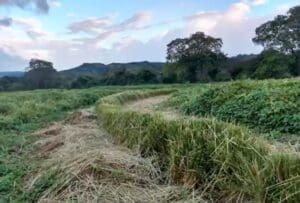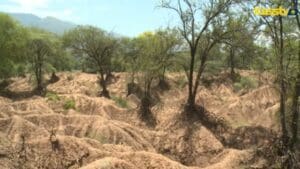The Vetiver Knowledge Gap

Most of those who read this newsletter fit cozily within the family of vetiver users around the world who when sharing information are most often “preaching to the choir” – not that we mind! We have to do more to get the information out to new users and to officials at various levels of government that Vetiver Grass Technology can help solve a lot of natural resources related problems at relative low cost (for most of us this starts with local government officials or our community neighborhood committee). Even though there is a mass of vetiver related data and information available, the lack of knowledge and understanding about VGT runs deep. Let me quote a note I received from someone acutely aware of the threat to his community from unprotected farms and infrastructure located in the higher up watersheds above the town where he lives. (I have removed names and place for the purpose of privacy).
“The Municipal Agricultural Officer is open and supportive of our idea and proposal for evaluation of Vetiver on coffee farms. We are in agreement that the first key to success is to establish a working, live and successful demonstration farm … The Municipal Agriculture Officer (MAO) appraised me of the true situation on our nearby mountain … he vented his frustration as to what he sees as a people, political and environmental problems. I can only agree with him. The uplands of our mountain are at a critical state of failure …. Being a seasoned agriculturist and public servant, the MAO is amazed at the potential of VGT. He only learned about Vetiver from me. The national government agencies have never had any programs to introduce Vetiver. ….. many past projects designed to preserve/ protect the ecosystem and educate farmers on sustainable farming have failed … Failures are due to: lack of foresight, good planning and strong political will on the part of the previous and current government authorities to regulate activities in the mountainous and hilly areas; and the influx of people (including non-locals) and their greediness to exploit the land (a supposedly protected zone) for agricultural production without thinking of the dire consequences and repercussions of their unsound agricultural practices. This attitude is further compounded by farmers resorting to farming the easy-way and taking shortcuts … The agriculture office is not making any headway because the government and the law lacks “the teeth”. There is no carrot and stick strategy adopted that would both encourage farmers to be cautious and protective of the source of their livelihood. The MAO failed (unable) to impose or demand strict compliance to land use regulations. Some of the agricultural technicians and extension workers were threatened by landowners ….”
The above is not new and is experienced in many countries. However, it is a reminder that if we are to progress in tackling climate change and soil health issues on the farm we need farmer acceptable technologies, some sensible land use regulations, and incentives for farmers that will encourage practical and mitigating practices. Farmers need recognition and support to conserve their resources. The communities that should be supporting such policies should be those impacted negatively by bad practices: the farmers themselves (lost soil, lost soil nutrients, lower yields and higher costs); downstream/down watershed rural and urban communities (polluted rivers, unwanted sediment deposits, increased flooding and land slide risk, and decreased and polluted groundwater). The cost of these and other off farm events due to poor farming practices are rarely included in economic analysis, and must be substantial. Helping farmers protect their land and watershed would be a lot cheaper than the cost of mitigating failure after damaging events.

On the assumption that VGT is the least cost and an effective way of stabilizing hilly farmland, along with the introduction of other regenerative agricultural practices for improving soil health, the cost of the vetiver plants (a total of 17.5 million plants) to protect the whole of the 5,000ha municipal watershed mentioned above would be in the order of $150/ha (at a current market price of 3-4 US cents/slip). It would not be unreasonable for these plants to be supplied as a grant to landowners in exchange for a farmer commitment to plant and maintain them correctly and to follow sustainable practices. I would also suggest that in many countries, because of limited supplies vetiver plant material is over-priced, and must be brought down if significant upscaling is to be successful. The best way of doing this is to encourage programs for many small nurseries owned and managed by the poorest of farmers, and guarantee sales in the early years.

Overall winner of the Vetiver short video competition
Piet Sabbe of Ecuador was the overall winner of this competition with his excellent video “Vetiver in the Farm and in the Landscape” . This will be a very useful video for introducing the simple “how to and why of planting vetiver” to some of the folks I mentioned in the above opening paragraphs. Runners up to Piet were Marietta Landis (Panama) with Sustainable Regeneration and Alois and Maria Kennerknech (Peru) with Vetiver Grass: Community Use in Urban Areas. Full details of all the awards by category can be found here. All 34 videos have been uploaded to TVNI’s YouTube channel. Congratulations and thank you all for participating.

New Latin America Vetiver Network (LAVN) Coordinator – Rafael Luque.
Rafael has kindly volunteered to take over as coordinator of the LAVN. He should be an excellent coordinator as he has many years of hands-on experience in introducing and applying the Vetiver System in Venezuela. You will find references to his work on TVNI’s website and his recent video relating to using VGT to meet UN climate goals can be found here. We believe that there are more VGT applications being applied in Latin America than we know of, and we hope that Rafael will be able to discover this work, and further upscale VS applications in the region. We also hope that he can encourage some of the key regional vetiver promoters, users and funding agencies to work in closer collaboration to accelerate VGT adoption..

TVNI makes a grant to key vetiver innovators and promoters in Kenya to support Regenerative Agriculture.
Two small grants have been made, with Vetiver as a critical component, to support the development of Regenerative Agricultural practices (RAV) through demonstration and training. This initiative includes some of Kenya’s leading vetiver farmers/practioners, including Jane Wegesa Fraser, Caleb Omolo, Christian Makokha, Peter Kingori, Paul Kombo and Samuel Teimuge. Besides RAV practices (soil and water conservation, soil health improvement, mulching, pest reduction), other farm vetiver applications will be demonstrated including farm pond and dam protection, gully rehabilitation, and drain stabilization. A key component will be the expansion and supply of vetiver plant material. These demo sites and nurseries will be for the long term and will be used to train other farmers and communities. The initiative is called UNVI (Umoja na Vetiver Initiative … Unity with Vetiver). An important objective under UNVI will be to bring together key vetiver users/trainers into an association that can provide a “vetiver platform” to bring focus to current VGT applications in Kenya and for future up scaling support to and by other organizations. This excellent video https://youtu.be/0_tMH2wIpy0 by Chemtai Kirui is about vetiver introduction and application in the badly eroded Kerio Valley. What is being done in the Valley, under the pioneership of Samuel Teimuge and Jane Wegesa Fraser, and in western Nyanza by Caleb Omolo, Christian Makokha, and Peter Kingori could be applied across sub-Sahara Africa.”.
St Vincent and the Grenadines update.
You may recall that in the June 2022 Newsletter https://www.vetiver.org/vetiver-monthly-newsletter-june-2022/ I wrote about Vonnie Roudette’s initiative to rehabilitate 80 year old vetiver created terraces. I recently came across a 1952 article by Ismael Velez of Puerto Rico and a 1989 article by John Greenfield — https://www.vetiver.org/LAVN_CARIB.htm — on the same topic. In January 2023 this short news article was published: https://www.stvincenttimes.com/north-leeward-farmers-agri-heritage-vetiver-grass-project/ reporting on Vonnie’s progress. It’s a story we should follow. One has to ask why do governments and agencies continue to promote high cost labor intensive terracing as against biological barriers when the latter are just as or more effective for erosion control, and should be the most attractive when considering all the attributes and benefits of VGT and its low cost of installation. Of course, 30, 50, 80 years ago no one knew the more recent discovered benefits of vetiver, but with experimentation and on farm feedback created over the past 25 years VGT applications should be common place. – they are not. Governments of many countries, with support from International agencies, have provided generous grants for “hard” engineered conservation structures, one has to ask why not the same for biological systems, such as VGT, that provide so much more, at a fraction of the cost.
ICV7 – Latest information from the organizers. The conference will be in person and online. Registration free for both
I understand that by mid-February we can expect a fully updated ICV7 website complete with a state of the art registration platform. There is not much point in registering until then. Before the website is updated you may go to this link for general information. https://icv-7.com/wp-content/plugins/pdf-poster/pdfjs/web/viewer.html?file=https://icv-7.com/wp-content/uploads/2023/01/ICV7-3rd-Announcement_edited2.pdf&download=true&print=vera&openfile=false
Currently the judging is taking place for the King of Thailand Vetiver Awards. 43 entries were submitted. Thus far the process is on schedule. Amongst the submissions are some useful and interesting papers covering research and field development.
New book published by China Vetiver Network

Edited by Liyu Xu and Hanping Xia. A book titled “Research and Applications of Vetiver System” was published by China Vetiver Network. The book include 6 chapters:
Chapter 1,General condition of application and development of Vetiver System.
Chapter 2: Ecologial characteristics and biological energy.
Chapter 3: Environmental treatment and ecological protection.
Chapter 4: Soil erosion and water and soil conservation.
Chapter 5: Vetiver planting, handicraft, and propagation.
Chapter 6: Extension and applications of Vetiver System.
Carbon Farming: Building Soils and Stabilizing the Climate by Eric Toensmeier
This, from Echo Development notes, is an excerpt from the forthcoming Carbon Farming: Stabilizing the Climate with Perennial Crops and Regenerative Agricultural Practices see: http://edn.link/carbon-farming. The Vetiver System fits in well with his comments/observations.
Research:
Application of Phyto-Remediation (Sunflower and Vetiver Grass) on Crude Oil Spilled Soil Cultivated to Jute
by Mallow (Corchorus Olitorius L.) Udo-Inyang U. Charles, Edem I. Dennis, John M. Nkereuwem
This study assessed the potential phytoremedial use of Tithonia diversifolia (Mexican sunflower) and Vetiveria nigritana (Vetiver Grass) on bioremediation of crude oil affected soils as an option that rendered harmless various contaminants using natural biological activity. It relatively low-cost, low techniques with high public acceptance and can often be carried out on site. The experiment consisted of three treatments; non-remediated soil (A), sunflower (B) and vetiver (C) remediated soils. The treatments in three replicates were laid out in a completely randomized design (CRD) layout. Soil physical conditions were significantly best under vetiver treated soils. Nevertheless, heavy metals concentration after the experiment was in the order of treatments A>B>C. Application of sunflower significantly (p<0.05) reduced the total hydrocarbon content in the soils by 25.59%, while vetiver grass had removal efficiency greater than 41%. Whereas the results of HUB/THBC ratio is in excess of 1% which tends to indicate recent crude oil input into the environment, the differences among the treatments were not significant. The percentage increment in leaf dry weight from 8 to 16 WAP was significantly lower (11%) in pots grown without treatment than those treated; soils treated with sunflower, the percent increment in biomass dry weight from 8 to 16 WAP was 84% and 139% for those treated with vetiver grass for the same period. However, the degree of toxicity on the tested plant was attributed to the direct contact of the toxic volatiles and water soluble hydrocarbons in spilled soil that might have penetrated the tissues of the tender plant.
Some Vetiver Facebook posts/photos in January



The video ‘ Vetiver Grass: Community Use in Urban Areas ‘ is so inspirational. The stiff erect stems blocking animal pests is a feature I hope to exploit.
The revival of eighty-year old plantings in St Vincent is inspiring too.
RIchard GRIMSHAW
We try to inspire! Thanks for your comment